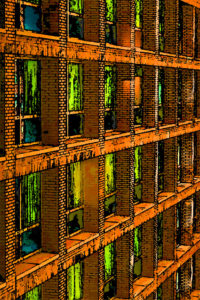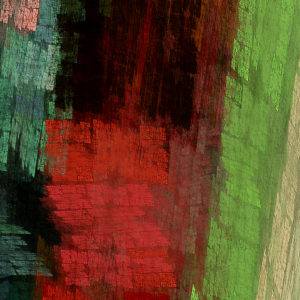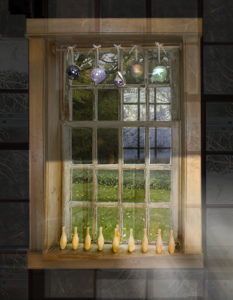Tomorrow, November 1st is the last chance to view newMediaART at University Place! Read below for more information about our 3 incredible Cambridge Art Association Members featured in this exhibit. Click here to learn more about the exhibit!

Wally Gilbert
Digital artist Wally Gilbert had a full career as a Molecular Biologist. Awarded a Nobel Prize in 1980 for discovering a rapid DNA sequencing method, he also co-founded Myriad Genetics and Biogen. Wally Gilbert is a professor Emeritus at Harvard University. Since the early 2000s, he has been creating visual art, amplifying the information in digital photographs using computers, and enhancing and transforming the lines and colors into a new and vibrant art form. His works in this exhibition are printed directly onto the surface of aluminum with a high gloss laminate that enhances the intensity of the colors. [www.wallygilbert.com]
To the artist…
How did your work in “digital art” begin? Years ago, I discovered that I could make large prints from images taken with a small digital camera and that these prints carried an emotional and aesthetic impact. It was then that I began making digital images as art. My earliest work was of fragments of the visual world – portions of natural scenes or of man’s architectural or industrial artifacts. My first one-person show included a 48”x72” image made from a two mega-pixel camera.
Where did that work take you? I was invited to Poland to do an installation at the Norblin Site in Warsaw by Jan Kubasiewicz and Josef Piwkowski. These photographs of decaying machinery were installed in Warsaw in the summer of 2007 as twenty-six 12’x8’ hangings and thirty 36” x 24” prints face-mounted on Plexiglas.
After photographing dancers in the ballet, I went on to explore abstractions, first in a “Vanishing” series that was based on a natural form, the outline of a human head. The many patterns produced in that series all shared some aspect of a biological or natural curve, which still was manifest even in the smallest cropping of those images.
In my later work, the basic element is a straight, shaded line, which I used to create geometric patterns. The “Geometric Series” explored patterns in color or black-and-white created from overlapping squares or triangles or just from lines, taken either simply in intersecting groups. My most recent work lies in two directions: one of pure abstractions based on overlapping forms, and the other of photographs moved to extreme values in color space or into black and white. I have also begun to explore projected videos that are made using programs that allow one to overlap video streams.
Do you have additional approaches? I make many images by hand on the computer. The computer simply holds the intermediate forms as I superpose the many layers I create to build up the image. The images begin in black and white, and then I color them in the computer. I generate these colors either by accessing the colors available or, in a more complicated fashion, by using the ability to change the global input-output functions for each color and intensity separately. When the layers containing the colored images interact with each other, still more color patterns appear. The computer is a digital workspace, driven by my hand and eye.
These images exemplify my delight in color and form, and my search for a three-dimensional effect on a two-dimensional surface. I search for depth beyond the picture plane and for mystery.

Gloria King Merritt
Digital artist Gloria King Merritt trained in a variety of traditional fine art techniques and media through a series of apprenticeships, including drawing, painting, metal, resin, color theory, and film. Her teachers encouraged a sound classical education, as well as experimentation beyond the boundaries of tradition. [www.merrittcontemporaryart.com/about]
To the artist…
How did your work in “digital art and new media” begin? Every generation invents a new artistic technique or medium to create new ways to express the concepts, thoughts, and feelings of the age. Art is, and always will be, an idea, not a medium. Just as the painter’s brush is an extension of their hand, so the computer is the extension of the creative mind.
In 1976, I was introduced to digital art through my teacher, Nathaniel Jacobson, a Yale-educated Color Theorist and research affiliate at the MIT Media Lab. In 1980, I worked in video as Art Director at the CBS affiliate broadcast television station in Boston. By 1985, I was working professionally with cutting- edge art involving technology. Then by 2011, I worked exclusively as a digital and new media artist, embracing technology that compliments and enhances the creative process, and blurs the edge between traditional media.
How do you describe “digital painting”? Digital painting is painting with light, on a backlit screen, forming layers of varying transparency, and creating a virtual three-dimensional image. When the layers are merged and the image is complete, it is translated to a final substrate, such as resin, metal, canvas, or paper, using archival pigments suspended in a medium. This allows the digital painting to be viewed within a contemplative personal space or gallery.
For additional information about the work of Gloria King Merritt, see the interview with Artscope magazine, July/August 2016

Dorothy Amore Pilla
Digital artist Dorothy Amore Pilla’s experience as a printmaker is reflected in the layering and multiple images in her digital art. The medium allows for a plasticity of the images central to her work.
Previously, Dorothy was Director of the Art Education Program for Tufts University and The School of the Museum of Fine Arts. She is a Gallery Artist at Galatea Gallery in Boston, and a member of the National Organization of Women Artist (NAWA) and the Massachusetts chapter of NAWA, a Gallery Artist at the South Shore Art Center in Cohasset, MA, the Cambridge Art Association, and the Plymouth Center for the Art. [www.dorothyamorepilla.com]
To the artist…
How do you describe “digital painting”? My work is partly representational and partly imaginary. Each digital photograph starts with a “snapshot”, a moment in time. In my studio, Working in Photoshop, I enhance and compose photographs into “digital paintings”. It is the combined mediums of digital photography and Photoshop tools that bring my imaginings to life.
Artistic license and Photoshop tools are essential to the subtle reconstruction of reality. My work represents not what I photographed, but rather my speculation about and the subject. As in painting, the results are composites of multiple images working together with design and color to create a visually dynamic solution.
My early concentration in printmaking, along with my experience in drawing, painting and traditional photography, has had a significant impact on my work. My roots as printmaker are reflected in the layering and multiple-imagery in my current work and, as in printmaking, each image evolves through a series of stages. As I build my images, the process of working digitally is, for me, much like the manipulation of color and form in layers using virtual tools and pigment.
What is the role of “photography” in your work? My photographic work speaks to observation, reflection and supposition. I photograph subjects of personal interest and curiosity. As I compose my images in photoshop, my work represents not what actually exists, as a documentary photograph might, but rather my impression, interpretation, and transformation of the reality I originally encountered.
My images go beyond representation of what actually was and visually speculate on what might have been or could be. I deconstruct and transform reality from authentic representation to complex images that embody the essence of the subject.
